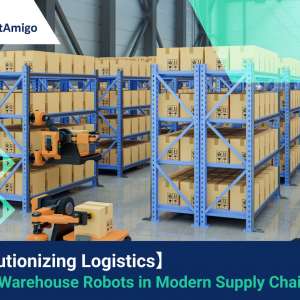Author Name: Tiffany Lee – Marketing Analyst at FreightAmigo
Introduction to Warehouse Robots
In today’s fast-paced world of logistics, efficiency and productivity are key factors that determine the success of a business. As the demand for faster and more accurate order fulfillment grows, warehouse robots have emerged as a game-changer in the fabric industry. These robots are revolutionizing the way fabric companies operate their warehouses, streamlining processes, and ultimately boosting efficiency and productivity.
Want To Compare The Best Express, Air Freight, Sea Freight, Rail Freight & Trucking Rates So As To Have Better Control On Cost?
Case Studies of Fabric Companies Using Warehouse Robots
To understand the impact of warehouse robots on efficiency and productivity in fabric warehouses, let’s take a closer look at two case studies.
Case Study 1:
Fabric Company A, a leading player in the industry, implemented warehouse robots in their distribution center. Previously, their manual picking process was time-consuming and prone to errors. With the introduction of robots, the company experienced a significant reduction in picking time. The robots efficiently navigated through the warehouse, locating and retrieving the required fabric rolls with precision. This automation not only saved time but also minimized the risk of damaged or misplaced inventory.
Case Study 2:
Fabric Company B, a relatively new entrant in the market, recognized the need to optimize their operations right from the start. By incorporating warehouse robots into their warehouse management system, they were able to achieve impressive results. The robots seamlessly integrated with their existing software, enabling real-time inventory tracking and efficient order fulfillment. As a result, the company experienced a remarkable increase in productivity, allowing them to meet customer demands faster and more accurately.
How Warehouse Robots Improve Efficiency and Productivity in Fabric Warehouses
Warehouse robots play a crucial role in enhancing efficiency and productivity in fabric warehouses in several ways.
1. Automated Picking and Sorting:
One of the most time-consuming tasks in a fabric warehouse is picking and sorting the inventory. Warehouse robots are equipped with advanced sensors and algorithms that enable them to navigate through the warehouse, locate the required fabric rolls, and pick them up with precision. This eliminates the need for manual labor, reduces the risk of errors, and significantly speeds up the picking process.
2. Inventory Management and Tracking:
Efficient inventory management is essential for any fabric company. Warehouse robots are equipped with barcode scanners and RFID technology, allowing them to scan and track inventory in real-time. This ensures accurate stock levels and eliminates the risk of stockouts or overstocking. With the ability to continuously monitor inventory, fabric companies can optimize their supply chain, reduce costs, and improve overall efficiency.
3. Streamlined Order Fulfillment:
Warehouse robots have revolutionized the order fulfillment process in fabric warehouses. They can quickly and accurately pick the required fabric rolls, pack them, and prepare them for shipping. With their speed and precision, robots enable fabric companies to fulfill orders faster, reducing lead times and enhancing customer satisfaction. Additionally, robots can also handle repetitive and labor-intensive tasks, freeing up human workers to focus on more complex and value-added activities.
The Different Types of Warehouse Robots and Their Functions
There are various types of warehouse robots, each designed for specific functions in fabric warehouses.
1. Autonomous Mobile Robots (AMRs):
AMRs are mobile robots that can navigate autonomously within the warehouse environment. They are equipped with sensors and cameras to detect obstacles and adapt to changing surroundings. AMRs are commonly used for picking and transporting fabric rolls, ensuring smooth and efficient warehouse operations.
2. Articulated Robotic Arms:
Articulated robotic arms are versatile robots capable of performing complex tasks with precision. They can be programmed to pick, sort, and stack fabric rolls, optimizing the warehouse layout and maximizing storage space. These robots excel in tasks that require dexterity and accuracy, contributing to increased efficiency in fabric warehouses.
3. Automated Guided Vehicles (AGVs):
AGVs are autonomous vehicles that follow predetermined paths or routes within the warehouse. They are commonly used for transporting heavy fabric rolls from one location to another. With their ability to carry heavy loads and navigate safely, AGVs significantly reduce the manual labor involved in material handling, enhancing productivity in fabric warehouses.
The Future of Warehouse Robotics in the Fabric Industry
The future of warehouse robotics in the fabric industry looks promising. As technology continues to advance, warehouse robots are becoming more intelligent, efficient, and adaptable. Here are some key trends to watch out for:
1. Artificial Intelligence and Machine Learning:
Artificial intelligence and machine learning algorithms are being integrated into warehouse robots, enabling them to learn from data and make intelligent decisions. This will further enhance their ability to optimize processes, adapt to changing demand patterns, and continuously improve efficiency and productivity.
2. Collaborative Robots:
Collaborative robots, also known as cobots, are designed to work alongside human workers. In fabric warehouses, cobots can assist with tasks that require human intervention, such as quality control and intricate fabric handling. The collaboration between humans and robots will result in higher productivity and improved working conditions.
3. Integration with Internet of Things (IoT):
The integration of warehouse robots with the Internet of Things (IoT) will enable real-time communication and data exchange between robots, machines, and systems in the fabric warehouse. This connectivity will streamline operations, optimize inventory management, and provide valuable insights for decision-making.
Conclusion: The Importance of Warehouse Robots in Modern Logistics
In conclusion, warehouse robots have become an indispensable asset in the fabric industry, enhancing efficiency and productivity in modern logistics. By automating tasks such as picking, sorting, and inventory management, these robots streamline operations, reduce errors, and enable fabric companies to meet customer demands faster and more accurately. As technology advances, warehouse robots will continue to evolve, playing an increasingly significant role in the future of fabric warehouses. Embracing warehouse robotics is not only a smart business decision but also a crucial step towards staying competitive in the fast-paced world of modern logistics.
There Are Different Options For Cargo Transportation. If You Want To Choose The Most Convenient And Suitable Solution, It Is Best To Have The Full Support Of Logistics Experts! If You Are Planning To Ship Goods Overseas, Please Go To The FreightAmigo Page For Inquiries.
===
Read More:
【Logistics News】Singapore to Sign Declaration on Green Shipping Corridors
FreightAmigo Won Startup Grand Award In TechChallenge — Digitising Trade Finance
Sailing Schedule: Streamlining Logistics Operations for Efficient Shipments
===
If you have any inquiries on logistics/supply chain, feel free to contact FreightAmigo now:
Chat with us online OR
Phone : +852 28121686
WhatsApp: +852 27467829









































